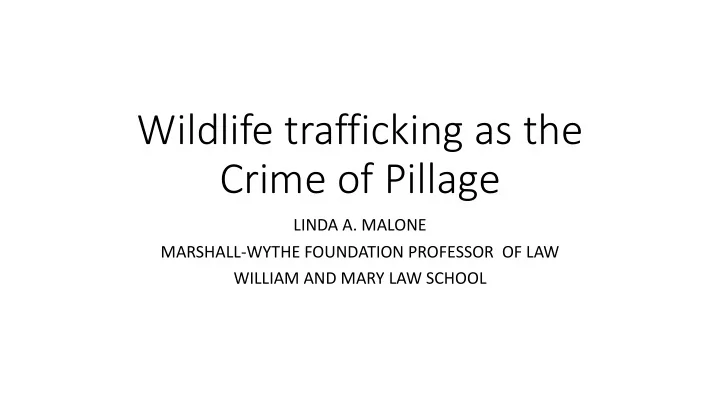

Wildlife trafficking as the Crime of Pillage LINDA A. MALONE MARSHALL-WYTHE FOUNDATION PROFESSOR OF LAW WILLIAM AND MARY LAW SCHOOL
• WILDLIFE TRAFFICKING IS THE THIRD MOST LUCRATIVE ILLEGAL ENTERPRISE, BEHIND TRAFFICKING OF GUNS AND DRUGS
THE MOST HIGHLY TRAFFICKED ANIMAL
THEFT OF RESOURCES AND DESTRUCTION OF CULTURAL ARTIFACTS
BLOOD DIAMONDS
worldwide wildlife trafficking in the range of $10 billion, with some estimates ranging as high as the $23 billion
ICC ART. 5(1) The elements for plunder are found in Article 8(2)(b)(xvi) of the International Criminal Court Elements of Crimes. This provision states that plunder may be prosecuted when: (1) The perpetrator appropriated certain property; (2) The perpetrator intended to deprive the owner of the property and to appropriate it for private or personal use; (3) The appropriation was without the consent of the owner; (4) The conduct took place in the context of and was associated with an international armed conflict; (5) The perpetrator was aware of factual circumstances that established the existence of an armed conflict.
• PROPERTY PROTECTED BY THE BAN ON APPROPRIATION “IS NOT LIMITED TO CIVILIAN PROPERTY.” • SIGNIFICANT IN A WILDLIFE CONTEXT BECAUSE WILD ANIMALS ARE NOT CONSIDERED CIVILIAN PROPERTY • “APPROPRIATION” IS NOT DEFINED UNDER THE ROME STATUTE OR IN THE ELEMENTS OF WAR CRIMES • “PRIVATE” OR “PERSONAL” USE ARE ALSO NOT DEFINED, BUT SHOULD BE CONSTRUED BROADLY ENOUGH TO INCLUDE CASES WHERE PROPERTY IS GIVEN TO THIRD PERSONS AND NOT ONLY USED BY THE PERPETRATOR
WILDLIFE TRAFFICKERS OF REBEL GROUPS IN CONFLICT AREAS • Recently, scholars have presented strong arguments that the traditional, narrow notions of pillage should be expanded to encompass a broader and more systematic context. Thus, under this expanded definition rebel group leaders who themselves may have not captured and sold wildlife could likely also be held responsible as perpetrators of pillage • • Prosecutors could show that the defendant intended the property for personal use by showing, for example, that the group transported or sold the poached wildlife and used the revenue for private gain, such as to purchase weapons, pay troops, or enrich themselves or their larger organization
• Beyond direct prosecutions for pillage, a compelling argument can also be made for the successful prosecution of rebel group leaders under an aiding and abetting theory of criminal liability • Article 25(b) states that “a person shall be criminally responsible and liable for punishment for a crime within the jurisdiction of the Court if that person . . . Orders, solicits or induces the commission of such a crime which in fact occurs or is attempted. Article 25(c) goes on to establish that a person will be criminally responsible for a crime if a person, “[f]or the purpose of facilitating the commission of such a crime, aids, abets or otherwise assists in its commission or its attempted commission, including providing the means for its commission.”
GOVERNMENT ACTORS IN CONFLICT AREAS • It is worth noting, there is arguably a distinction in some government cases from similar rebel group prosecutions. Rebel groups are always clearly appropriating property from an owner outside that group (for example from a private individual, from the currently recognized public sovereign, or possibly some combination). However, it could be argued that the government actors are not, in reality, appropriating at all because the trafficked animals or animal parts are already “owned” by the State. This argument may carry some merit, but would depend heavily on the specific factual circumstances involved. Although most legal systems around the world address the issue of wildlife ownership, there is no consistent system. In many countries wildlife is owned by the State, either as a rule or because wildlife occurs on State lands. However, in other countries wildlife is “owned” by the State, but this ownership may be “vested in the government on behalf of the and for the benefit of the people.” In others, such as Zimbabwe, there has been an elimination of the distinctions between private and public ownership
CORPORATE ENTERPRISE LIABILITY • Scholars have advanced a “corporate approach” to prosecuting pillage with the goal of extending criminal liability to corporations and other purchasers of materials stolen during armed conflicts. On this model, the elements required for the crime of pillage are met: appropriation, intent to deprive, and lack of consent by the rightful owner. However, in addition, the elements necessary for aiding-and-abetting liability are also applied to the corporation in question. Thus, criminal liability is expanded to include defendants who were not themselves directly involved in the illegal appropriation. • A conspicuous complaint with this theory is the problem of how to connect these far removed people or entities to the original theft. The corporate purchaser or company may be criminally liable only if it materially contributed to the crime and intended that the original crime be committed
ALSO… • UN CONVENTION AGAINST CORRUPTION • UN CONVENTION AGAINST TRANSNATIONAL ORGANIZED CRIME • CONVENTION ON INTERNATIONAL TRADE IN ENDANGERED SPECIES • SO WHY THE NEED FOR PILLAGE BEFORE THE ICC?
Recommend
More recommend